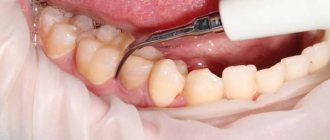Dental fluorosis is a dental pathology that occurs due to excessive amounts of fluoride. It is epidemic and chronic in nature. It occurs more often in certain areas where the drinking water contains excess fluoride.
We will tell you in this article how to recognize the disease in time and how to protect yourself from fluorosis.
What are the causes of pathology
In accordance with generally accepted sanitary standards, the maximum concentration of fluorine compounds in water should not exceed 1.5 mg/l. But it should be remembered that fluoride also enters the body during breathing and through food. An excess of this microelement negatively affects tooth enamel and begins to destroy it. If you do not consult a doctor in time, bone tissue pathologies may develop - osteoporosis or osteosclerosis.
Important! The occurrence of the disease is associated with the individual characteristics of the body. Sometimes fluorosis develops at lower concentrations of fluoride.
Mainly permanent teeth are affected, in rare cases – milk teeth in children. This is due to the fact that the mineralization of the baby’s first teeth begins and ends during the period of intrauterine development. At this time, the placenta protects the child’s body from an excess of fluoride. But if a pregnant woman lives in an area where the content of fluoride compounds in the water greatly exceeds the norm, then the disease can also affect the child’s baby teeth.
Children aged 3–4 years are at risk if they have consumed water with a high content of fluoride compounds for 3 or more years. This disease is also diagnosed in adults who work in industries with high levels of fluoride in the air.
When is there too much fluoride?
There are several cases when the amount of fluoride can harm the human body and provoke the disease fluorosis:
- An excess of fluoride obtained from water and food is endemic fluorosis. As a rule, it can develop even at the stage of fetal formation in a woman. The teeth become covered with white spots. Over time, they darken and visually resemble caries.
- Excess microelement in production. If a person has worked under poor working conditions for more than 10 years, fluorosis affects his internal organs and bones, and osteosclerosis, osteoporosis, and cancer may develop.
As we can see, fluoride can be dangerous to health only if a person receives an excess of it. However, in everyday life, it is almost impossible to “sort out” fluoride from toothpaste and food products, so information about the dangers of fluoride in toothpaste is greatly exaggerated. Your dentist will be the best person to tell you whether you need this paste or not and which brand to choose.
The iOrtho clinic network provides high-quality services for correcting malocclusion with Invisalign aligners, sign up for a consultation now!
Classification of the disease
Depending on the severity of the pathology, the following forms are distinguished:
- Streaked – characterized by the appearance of small stripes or streaks on the surface of the tooth. The upper jaw is most often affected by this form. The stripes are faint and cannot always be seen independently. Over time, they merge into one spot, in which strokes can also be distinguished.
- Spotted - this form is characterized by the presence of multiple chalky spots. They are well defined and located on the entire surface of the tooth. When drained, large spots form.
- A chalky-altered form - it is characterized by the presence of an affected light brown area, which turns into healthy enamel. This lesion is most often observed on the upper and lower incisors.
- Chalky-mottled - characterized by the presence of clear pigment spots. Sometimes there may be a variant of the presence of multiple dots on the enamel of a yellowish color. With this form, rapid thinning of the enamel is observed.
- Erosive - in addition to stains on the enamel, erosive defects occur. They contribute to the destruction of not only enamel, but also dentin.
- Destructive is the most severe form, in which the shape of the tooth crown is disrupted. This occurs due to thinning of the enamel and destruction of hard tooth tissue. The teeth themselves are quite fragile, prone to various damages (chips, breaks).
The disease can occur in mild, moderate and severe degrees. This depends on the number of teeth affected, as well as the depth of the pathological process. In severe cases, the patient experiences damage to more than 80% of the teeth. In this case, dentin is affected and crown deformation is observed. Fluorosis can also cause pathological disorders of skeletal bones.
What is fluoride?
Fluorine is a chemical element widespread in nature, compounds of which are found in the earth’s crust, volcanic gases, thermal and artesian waters. It is part of plant tissues and is present in the bones of animals and humans. In terms of oral health, fluoride compounds are effective in protecting teeth from tooth decay.
Tooth enamel is constantly subject to demineralization and remineralization. During demineralization, mineral components are washed out from the structure of the enamel or other hard tissue of the tooth. A significant decrease in their concentration leads to tooth decay. On the contrary, during the remineralization process, fluoride ions penetrate the hard tissues of the tooth, and the balance of minerals in the enamel is restored.
Manifestations of the disease
Symptoms depend on the form and severity of the disease. At the very beginning (at the stage of spotty or streaked form), areas with a changed color appear on the surface of the tooth. Stripes and lines are also visible. The enamel itself becomes rough, and small bulges appear.
Subsequently, small spots lead to the formation of larger pathological areas. Inhomogeneous mineralization of tooth enamel occurs. It breaks down and takes on a dull, matte color. At the same time, the smoothness and shine disappears.
A person with fluorosis complains:
- to increase sensitivity to temperature stimuli;
- cosmetic defect, as the color of the enamel becomes yellowish or light brown;
- fragility and rapid wear of teeth;
- frequent chipping;
- multiple caries.
X-rays reveal areas with reduced density, which indicates the process of demineralization, that is, a decrease in mineral substances in the enamel structure. It is for this reason that coloring substances are able to penetrate the porous structure of the tooth surface, which leads to the appearance of pigmented areas.
Beneficial properties, the effect of fluoride on the body
Fluoride promotes the development and hardening of tooth enamel. It helps treat tooth decay by preventing harmful microorganisms found in diseased teeth from producing acid.
This microelement is involved in the development of the skeleton and the healing of bone tissue during fractures.
Fluoride prevents the development of senile osteoporosis, activates hematopoietic processes, and slows down the formation of lactic acid from carbohydrates.
The trace element fluorine reduces the accumulation of strontium radionuclide in bones and reduces the consequences of its radiation damage.
Together with calcium and phosphorus, fluoride ensures the strength of teeth and bones.
Dental fluorosis: treatment and prevention
Diagnosis is carried out at a dentist's appointment. Only a specialist will be able to distinguish the manifestations of fluorosis from a chalk spot, which is the initial stage of a carious lesion. An important distinguishing feature is that fluorous spots are multiple in nature and affect permanent teeth almost immediately after eruption. While initial caries in the spot stage is observed on single teeth.
Treatment is selected individually and depends on how severely damaged the enamel is. At the initial stage of the disease, it is recommended to conduct a course of professional whitening followed by strengthening the enamel using remineralization.
In this case, bleaching is carried out with a gentle composition based on inorganic acids. The number of procedures is selected by the doctor. Usually at least 10 sessions. During the whitening period, it is recommended to take calcium supplements. The result lasts for 6–8 months, then a second course of professional cleaning and bleaching is required.
The remineralization procedure helps strengthen the enamel structure, saturating it with minerals. Calcium and phosphorus compounds penetrate dentin and restore enamel from the inside. This procedure is carried out in several ways:
- Applications with a special composition.
- Electrophoresis or phonophoresis.
- Wearing mouth guards in which active gel is applied.
On average, at least 15 procedures are prescribed. Before the procedure, complete sanitation of the oral cavity is mandatory.
If the disease has already spread to the dentin, then simply bleaching will be ineffective. For moderate severity of fluorosis, methods of aesthetic tooth restoration are used:
- installation of ceramic veneers;
- restoration of tooth shape and color using crowns.
Such methods are recommended not only for aesthetic purposes, but also for medicinal purposes. They help stop further tooth decay and reduce enamel sensitivity.
Home care is also important - using fluoride-containing toothpastes, taking vitamin and mineral complexes, reducing the intake of fluoride from water and food.
How to prevent the disease from developing
The main preventive measure to combat fluorosis is to control the amount of fluoride in drinking water, as well as in the air. Such measures are especially important for areas where the amount of fluoride in the population’s water supply has been found to exceed the norms. Such events are held at the state level.
On an individual basis, it is recommended to use purchased purified water for drinking or use tap filters for additional purification. At the same time, it is important to engage in prevention from the moment the child is conceived. A pregnant woman should be especially careful when choosing food and drinking water. Additional intake of vitamins C, D, and calcium gluconate can reduce the risk of fluorosis several times, especially in children.
When a baby is born, it is recommended to feed him breast milk for as long as possible. After introducing complementary foods, use juices or dairy products instead of water, if possible. If you live permanently in an endemic area, you need to take your children to other areas every year for health improvement. Replacing the water source for 3-4 months helps strengthen tooth enamel and stop the development of the disease.
An important point in disease prevention is nutrition. Limit or completely eliminate products containing fluoride. These are sea fish, nuts, spinach, seaweed. You need to eat more fresh vegetables or fruits.
Also, after consulting a doctor, you can use medicinal remineralizing toothpastes or applications at home.
Signs of fluoride deficiency
One of the most telling signs of fluoride deficiency is tooth decay. Bacteria that accumulate on teeth as part of plaque consume sugars and carbohydrates, producing organic acids that destroy tooth enamel.
A clear indication of fluoride deficiency is the high level of dental caries in children. In many regions of Russia, there is a low level of fluoride in drinking water, which increases the risk of dental diseases among the population. In order to prevent dental caries in such cases, water fluoridation is sometimes used. According to researchers, drinking fluoridated water reduces the likelihood of developing tooth decay in children and adults by 25-30%.
Deficiency of a substance in the body
Often, with insufficient consumption, symptoms are poorly developed, and negative manifestations do not appear immediately. Because of this, people often turn to doctors only in advanced stages of illness.
A lack of microelements leads to disruptions in the functioning of internal organs and systems.
Bones become fragile, brittle, and more easily injured. Tooth enamel also becomes thinner, which increases the risk of developing dental pathologies and caries. Nails become brittle and peel. Hair becomes dull, splits, and occasionally may fall out.
Since a lack of fluoride reduces the amount of absorbable iron, the concentration of hemoglobin in the blood also becomes low. Anemia develops. Visual acuity decreases. The spinal column is curved. The immune system weakens, the person begins to get sick more often.










